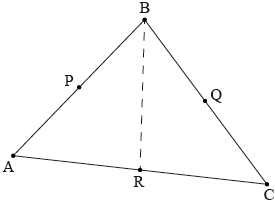Question

Consider the triangle \(ABC\). The points \(P\), \(Q\) and \(R\) are the midpoints of the line segments [\(AB\)], [\(BC\)] and [\(AC\)] respectively.
Let \(\overrightarrow {{\text{OA}}} = {{a}}\), \(\overrightarrow {{\text{OB}}} = {{b}}\) and \(\overrightarrow {{\text{OC}}} = {{c}}\).
a.Find \(\overrightarrow {{\text{BR}}} \) in terms of \({{a}}\), \({{b}}\) and \({{c}}\).[2]
(i) Find a vector equation of the line that passes through \(B\) and \(R\) in terms of \({{a}}\), \({{b}}\) and \({{c}}\) and a parameter \(\lambda \).
(ii) Find a vector equation of the line that passes through \(A\) and \(Q\) in terms of \({{a}}\), \({{b}}\) and \({{c}}\) and a parameter \(\mu \).
(iii) Hence show that \(\overrightarrow {{\text{OG}}} = \frac{1}{3}({{a}} + {{b}} + {{c}})\) given that \(G\) is the point where [\(BR\)] and [\(AQ\)] intersect.[9]
c.Show that the line segment [\(CP\)] also includes the point \(G\).[3]
d.The coordinates of the points \(A\), \(B\) and \(C\) are \((1,{\text{ }}3,{\text{ }}1)\), \((3,{\text{ }}7,{\text{ }} – 5)\) and \((2,{\text{ }}2,{\text{ }}1)\) respectively.
A point \(X\) is such that [\(GX\)] is perpendicular to the plane \(ABC\).
Given that the tetrahedron \(ABCX\) has volume \({\text{12 unit}}{{\text{s}}^{\text{3}}}\), find possible coordinates
of \(X\).[9]
▶️Answer/Explanation
Markscheme
\(\overrightarrow {{\text{BR}}} = \overrightarrow {{\text{BA}}} + \overrightarrow {{\text{AR}}} \;\;\;\left( { = \overrightarrow {{\text{BA}}} + \frac{1}{2}\overrightarrow {{\text{AC}}} } \right)\) (M1)
\( = ({{a}} – {{b}}) + \frac{1}{2}({{c}} – {{a}})\)
\( = \frac{1}{2}{{a}} – {{b}} + \frac{1}{2}{{c}}\) A1
[2 marks]
(i) \({{\text{r}}_{{\text{BR}}}} = {{b}} + \lambda \left( {\frac{1}{2}{{a}} – {{b}} + \frac{1}{2}{{c}}} \right)\;\;\;\left( { = \frac{\lambda }{2}{{a}} + (1 – \lambda ){{b}} + \frac{\lambda }{2}{{c}}} \right)\) A1A1
Note: Award A1A0 if the \({\text{r}} = \) is omitted in an otherwise correct expression/equation.
Do not penalise such an omission more than once.
(ii) \(\overrightarrow {{\text{AQ}}} = – {{a}} + \frac{1}{2}{{b}} + \frac{1}{2}{{c}}\) (A1)
\({{\text{r}}_{{\text{AQ}}}} = {{a}} + \mu \left( { – {{a}} + \frac{1}{2}{{b}} + \frac{1}{2}{{c}}} \right)\;\;\;\left( { = (1 – \mu ){{a}} + \frac{\mu }{2}{{b}} + \frac{\mu }{2}{{c}}} \right)\) A1
Note: Accept the use of the same parameter in (i) and (ii).
(iii) when \(\overrightarrow {{\text{AQ}}} \) and \(\overrightarrow {{\text{BP}}} \) intersect we will have \({{\text{r}}_{{\text{BR}}}} = {{\text{r}}_{{\text{AQ}}}}\) (M1)
Note: If the same parameters are used for both equations, award at most M1M1A0A0M1.
\(\frac{\lambda }{2}{{a}} + (1 – \lambda ){{b}} + \frac{\lambda }{2}{{c}} = (1 – \mu ){{a}} + \frac{\mu }{2}{{b}} + \frac{\mu }{2}{{c}}\)
attempt to equate the coefficients of the vectors \({{a}}\), \({{b}}\) and \({{c}}\) M1
\(\left. {\begin{array}{*{20}{c}} {\frac{\lambda }{2} = 1 – \mu } \\ {1 – \lambda = \frac{\mu }{2}} \\ {\frac{\lambda }{2} = \frac{\mu }{2}} \end{array}} \right\}\) (A1)
\(\lambda = \frac{2}{3}\) or \(\mu = \frac{2}{3}\) A1
substituting parameters back into one of the equations M1
\(\overrightarrow {{\text{OG}}} = \frac{1}{2} \bullet \frac{2}{3}{{a}} + \left( {1 – \frac{2}{3}} \right){{b}} + \frac{1}{2} \bullet \frac{2}{3}{{c}} = \frac{1}{3}({{a}} + {{b}} + {{c}})\) AG
Note: Accept solution by verification.
[9 marks]
\(\overrightarrow {{\text{CP}}} = \frac{1}{2}{{a}} + \frac{1}{2}{{b}} – {{c}}\) (M1)A1
so we have that \({{\text{r}}_{{\text{CP}}}} = {{c}} + \beta \left( {\frac{1}{2}{{a}} + \frac{1}{2}{{b}} – {{c}}} \right)\) and when \(\beta = \frac{2}{3}\) the line passes through
the point \(G\) (ie, with position vector \(\frac{1}{3}({{a}} + {{b}} + {{c}})\)) R1
hence [\(AQ\)], [\(BR\)] and [\(CP\)] all intersect in \(G\) AG
[3 marks]
\(\overrightarrow {{\text{OG}}} = \frac{1}{3}\left( {\left( {\begin{array}{*{20}{c}} 1 \\ 3 \\ 1 \end{array}} \right) + \left( {\begin{array}{*{20}{c}} 3 \\ 7 \\ { – 5} \end{array}} \right) + \left( {\begin{array}{*{20}{c}} 2 \\ 2 \\ 1 \end{array}} \right)} \right) = \left( {\begin{array}{*{20}{c}} 2 \\ 4 \\ { – 1} \end{array}} \right)\) A1
Note: This independent mark for the vector may be awarded wherever the vector is calculated.
\(\overrightarrow {{\text{AB}}} \times \overrightarrow {{\text{AC}}} = \left( {\begin{array}{*{20}{c}} 2 \\ 4 \\ { – 6} \end{array}} \right) \times \left( {\begin{array}{*{20}{c}} 1 \\ { – 1} \\ 0 \end{array}} \right) = \left( {\begin{array}{*{20}{c}} { – 6} \\ { – 6} \\ { – 6} \end{array}} \right)\) M1A1
\(\overrightarrow {{\text{GX}}} = \alpha \left( {\begin{array}{*{20}{c}} 1 \\ 1 \\ 1 \end{array}} \right)\) (M1)
volume of Tetrahedron given by \(\frac{1}{3} \times {\text{Area ABC}} \times {\text{GX}}\)
\( = \frac{1}{3}\left( {\frac{1}{2}\left| {\overrightarrow {{\text{AB}}} \times \overrightarrow {{\text{AC}}} } \right|} \right) \times {\text{GX}} = 12\) (M1)(A1)
Note: Accept alternative methods, for example the use of a scalar triple product.
\( = \frac{1}{6}\sqrt {{{( – 6)}^2} + {{( – 6)}^2} + {{( – 6)}^2}} \times \sqrt {{\alpha ^2} + {\alpha ^2} + {\alpha ^2}} = 12\) (A1)
\( = \frac{1}{6}6\sqrt 3 |\alpha |\sqrt 3 = 12\)
\( \Rightarrow |\alpha | = 4\) A1
Note: Condone absence of absolute value.
this gives us the position of \(X\) as \(\left( {\begin{array}{*{20}{c}} 2 \\ 4 \\ { – 1} \end{array}} \right) \pm \left( {\begin{array}{*{20}{c}} 4 \\ 4 \\ 4 \end{array}} \right)\)
\({\text{X}}(6,{\text{ }}8,{\text{ }}3)\) or \(( – 2,{\text{ }}0,{\text{ }} – 5)\) A1
Note: Award A1 for either result.
[9 marks]
Total [23 marks]
